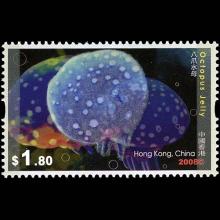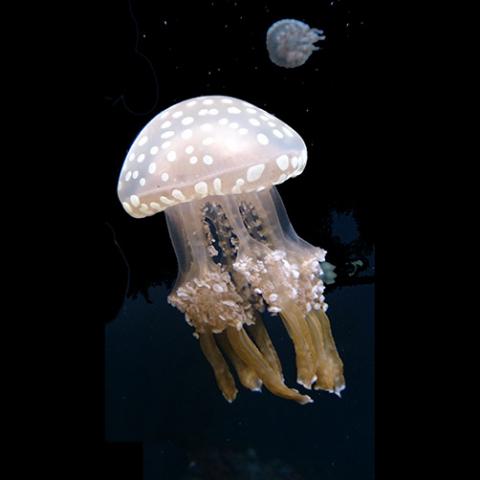NAMES
TAXONOMY
Hong Kong
Issued:
Stamp:
Phyllorhiza punctata
Hong Kong
Issued:
Stamp:
Phyllorhiza punctata
Hong Kong
Issued:
Stamp:
Phyllorhiza punctata
Genus species (Animalia): Phyllorhiza punctata
Phyllorhiza punctata is a species of jellyfish, also known as the floating bell, Australian spotted jellyfish, brown jellyfish or the white-spotted jellyfish. It is native to the western Pacific from Australia to Japan, but has been introduced widely elsewhere. It feeds primarily on zooplankton. Phyllorhiza punctata generally can reach up to 50 centimeters (20 in) in bell diameter, but in October 2007, one 72 cm (28 in) wide, perhaps the largest ever recorded, was found on Sunset Beach, North Carolina
Description
True jellyfish go through a two-stage life cycle which consists of a medusa stage (adult) and a polyp stage (juvenile). In the medusa stage male jellyfish release sperm into the water column and the female jellyfish gathers the sperm into her mouth where she holds the eggs. Once fertilization occurs and larvae are formed they leave their mother and settle to the ocean floor. Once on the bottom a polyp form occurs and this form reproduces asexually by "cloning" or dividing itself into other polyps. Jellyfish can live for up to five years in the polyp stage and up to two years in the medusa stage(active).
When found in warm waters these jellyfish flourish. They are mostly euryhaline but low salinities may have a negative effect on the species. In times of low salinity these jellyfish exhibit loss of their zooxanthellae. Their dispersal patterns are locally patchy.
They have only a mild venom and are not considered a threat to humans. They have a mild or non-noticeable sting which can be cured with dilute acid. (Usually white or cider vinegar)
Reference: Wikipedia
Note: As there was no wikipedia (or any other) entry for "Octopus Jelly," the genus species was identified as "Phyllorhiza punctata" based on the stamp image and the the white spots on the jellyfish bell.


